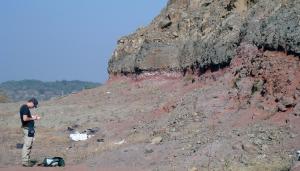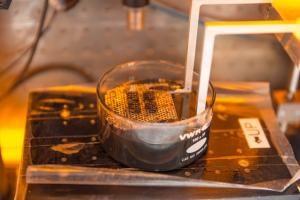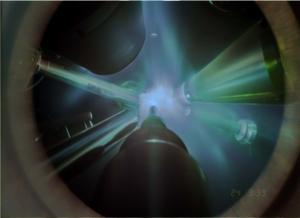LAB REPORT
Science and Technology Making Headlines
Feb. 22, 2019


This is a representative outcropping of what many of the team’s sampling locations look like in the Deccan Traps region of India. The red band in the rock outcropping is what is informally termed a “red bole,” essentially an ancient soil developed during a hiatus in volcanism between the underlying (older) lava flow and overlying (younger) lava flow.
The real Dino killer: A one-two punch
Not by meteorite alone did the dinosaurs die off.
Lawrence Livermore National Laboratory research scientist Kyle Samperton and colleagues present the most compelling evidence yet that massive volcanic eruptions in the Deccan Traps region of India contributed to the fall of the dinosaurs — also known as the end-Cretaceous mass extinction — approximately 66 million years ago. The research appeared this week in the journal Science.
Samperton’s team exhibits the most precise Deccan eruptive timeline yet, aligning the dinosaur extinction with massive volcanic events that occurred around the same time of the Chicxulub meteorite impact in Mexico. The meteorite impact has long been viewed as the primary (if not sole) cause of the mass extinction at the Cretaceous-Paleogene boundary, the geological moment when many creatures from the age of dinosaurs vanish from the fossil record.
However, the team’s new findings suggest Deccan eruptions were highly nonlinear, with four major volcanic pulses. According to their eruptive age model, the largest of these volcanic pulses immediately precedes the mass extinction event with an approximate 90 percent probability.
“This is one of the biggest one-two punches in Earth’s history, with two remarkably rare and destructive events occurring contemporaneously,” Samperton said. “It’s no wonder life didn’t do so well at the time.”


A series of mechanical logic gates are 3D-printed using the Large Area Projection Microstereolithography (LAPµSL) method. Photo by Julie Russell/LLNL
Blast from the past
Taking a page from the past, Lawrence Livermore National Laboratory scientists and engineers are combining mechanical computing with 3D printing as part of an effort to create “sentient” materials that can respond to changes in their surroundings, even in extreme environments that would destroy electronic components, such as high radiation, heat or pressure.
Original computers, like Charles Babbage’s Difference Engine, were fully mechanical, filled with gears and levers that turned, moved and shifted to solve complex mathematical calculations. After World War II and the rise of vacuum tubes and electronic circuits, mechanical computers mostly went the way of the dodo. However, putting a new twist on the old technology, LLNL researchers and contributors from the University of California, Los Angeles (UCLA) are 3D printing mechanical logic gates — the basic building blocks of computers capable of performing any kind of math calculations.
Like LEGOs, these 3D-printed logic gates could be used to build just about anything, researchers said, embedded into any type of architected material and programmed to react to its environment by physically changing shape without the need for electricity, useful in areas of high radiation, heat or pressure.

A new class of Lab-developed “field-responsive mechanical metamaterials” (FRMMs) employ a viscous, magnetically responsive fluid that is manually injected into the hollow struts and beams of 3D-printed lattices. The fluid’s ferromagnetic particles located in the core of the beams form chains in response to the magnetic field, which rapidly stiffens the fluid and the lattice structure. Photo by Julie Mancini/LLNL
Four is the magic number
Ever heard of 4D printing? The concept itself isn’t too difficult to understand. If 3D printing is layer-by-layer fabrication of an object, then 4D printing adds the fourth dimension: time. Once produced, a 4D-printed object reacts to its environment and changes over time. In this way, a 4D-printed object is a form of programmable matter.
One team from Lawrence Livermore National Laboratory has found applications for 4D printing in the form of metamaterials — materials that change their shape or other physical properties depending on the environment or application.
Most recently, LLNL created “field-responsive mechanical metamaterials” that stiffen when hit with a magnetic field. While the matter (filled with ferromagnetic particles) itself isn’t printable, it can be injected into hollow, 3D-printed lattice structures that, when exposed to a magnetic field, the structures stiffen. When the force is removed, the structures return to their relaxed state. By changing the power of the magnetic force, you can change the stiffness of the objects.
This process could potentially be used to create helmets, neck braces, optics or soft robotics. The researchers even think that it could be incorporated into vehicle seats so that when sensors detect a crash, the seats might stiffen to prevent whiplash.


Researchers used their new 3D printing technology to create a model of Rodin’s “The Thinker.” Photo by Stephen McNally/UC Berkeley
Lighting the way
A new 3D printer uses light to transform gooey liquids into complex solid objects in only a matter of minutes.
Nicknamed the ‘replicator’ by the Lawrence Livermore and UC Berkeley inventors — after the Star Trek device that can materialize any object on demand — the 3D printer creates objects that are smoother, more flexible and more complex than can be produced by traditional 3D printers. It can also encase an already existing object within new materials — for instance, adding a handle to a metal screwdriver shaft — which current 3D printers struggle to do.
The technology has the potential to transform how products from prosthetics to eyeglass lenses are designed and manufactured, the researchers say.

Compression experiments allow liquid water to be driven to an extremely under-cooled state and nucleate a high-pressure polymorph known as ice VII. This unique phase of ice is believed to exist near the core of "ocean world” planets, recently detected by observation.
Fast freeze
Lawrence Livermore researchers suggest that an exotic phase of water, known as “ice VII” could grow at rates exceeding 1,000 miles per hour under the atmospheric conditions found on alien ocean worlds.
Water exists in three main phases (solid, liquid, and gas) and the phase it occupies is a function of atmospheric pressure and temperature. The solid form of water — ice — has several phases of its own, however most of them exist at extremely low temperatures (but some of them can exist at temperatures upwards of 1300 degrees Fahrenheit so long as the pressure is high enough).
Ice VII made headlines last year when it was discovered trapped in diamonds that were formed more than 400 miles beneath the Earth’s surface. This discovery suggested that liquid water exists deep within Earth’s core, but it was also the first time that ice VII was seen outside of a lab.
Now, theorists at Lawrence Livermore have demonstrated how water transitions to ice VII, a process known as “nucleation,” which helps explain how this exotic phase of ice forms on alien ocean planets.





